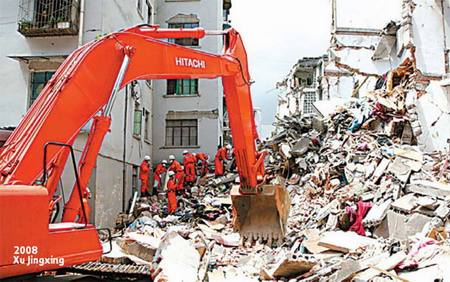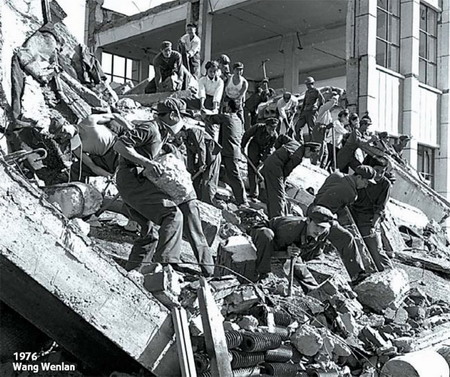
|
BIZCHINA> Wen's Lens
 |
|
Related
The task ahead
By You Nuo (China Daily)
Updated: 2008-06-09 17:16
  Victims of the recent Sichuan earthquake are laying the ground for rebuilding their lives. With soldiers and volunteers from all over the country, they are knocking down the dangerous old buildings, clearing up the debris, and starting to rebuild - first with makeshift residential quarters, and then to implement the plans for new cities. The current color photo, taken by China Daily photographer Xu Jingxing, shows how this is going on in the quake zone. Our 1976 black-and-white photo, taken by Wang Wenlan, shows rebuilding in Tangshan following the quake there.
 On June 3, the State Council, or the Chinese cabinet, commissioned the feasibility study for long-term redevelopment of the quake zone. To be sure, rebuilding cities in an earthquake zone is never easy, but rebuilding in Sichuan is going to be particularly difficult if all the people who lost their homes are to be resettled in their old locales and lifestyles. There will be daunting challenges and the overall task is huge. The Chinese press reports that there are at least 5 million of them, and the number of homeless could be as high as 15 million. Second, there is a time pressure. Neither the government nor the general public can allow people in the quake zone to spend years in tents or other temporary dwellings. After the Tangshan earthquake in 1976, some people could not move into their new houses for close to 10 years. But so much waiting is inhumane and with a much stronger economy now, China must provide the victims with the proper housing arrangements as quickly as possible. Third, it is almost impossible, and too dangerous in some cases, to rebuild the collapsed cities and towns on their original sites. Former residents of some cities and towns on the fault line will have to be relocated to safer places. The government has yet to tell us how many people will have to be resettled. Judging from the past experience, the largest government-sponsored relocation program for the Three Gorges Dam project involved only 1 million people. Presumably, the future Sichuan relocation program will include many more people. Fourth, a new land development model will have to be introduced. In China - let alone Sichuan - it is already impossible to find new land resources for relocating up to 15 million homeless people if they are to remain farmers. The new cities, no matter where they are to be built, will have to be of considerable size and able to provide their residents with suitable jobs. Only cities can use land resources more economically and generate a larger variety of jobs and opportunities for the locals. That task would be like relocating almost the entire population of Florida and putting all of them into one or several cities. This is something that neither Beijing, nor any government in the world, has ever done before. But China has no dearth of experience in building cities in a few decades' time. It has been building new cities through its reform era - like Shenzhen and Zhuhai in the 1980s, Shanghai's Pudong in the 1990s, Tianjin's Binhai and Tangshan's Caofeidian in breathtaking speed. Wherever the government is willing to give a full play to the private sector's initiatives, there is more rapid urban development.
(For more biz stories, please visit Industries)
|
主站蜘蛛池模板: 欧美一级高清片欧美国产欧美 | 毛片视频免费观看 | 一级毛片私人影院老司机 | 亚洲一区二区久久 | 国产丝袜美女一区二区三区 | 日韩欧美一级毛片精品6 | 国产成人精品日本亚洲专一区 | 伊人精品视频 | 欧美精品人爱c欧美精品 | 中美日韩在线网免费毛片视频 | 日本一级特黄a大片 | 国产一区二区三区视频 | 国产性大片黄在线观看在线放 | 一级aaaaaa毛片免费同男同女 | 国产精品久久国产三级国不卡顿 | 亚洲视频国产 | 国产在线精品观看一区 | 国产www | 韩国毛片在线观看 | 动漫一级毛片 | 欧美成人精品大片免费流量 | 国产精品99久久免费观看 | 成熟女人免费一级毛片 | 日日干日日操日日射 | 欧美日韩在线视频一区 | 国产精品免费视频一区一 | 久久成人性色生活片 | 激情欧美日韩一区二区 | 亚洲作爱视频 | 国产午夜人做人视频羞羞 | 77yyxf影音先锋 | 久久久久在线观看 | 欧美日本在线三级视频 | 久久久久亚洲 | 操12p| 日韩在线专区 | 日本美女视频韩国视频网站免费 | 男人使劲躁女人视频小v | 免费精品在线 | 特级欧美午夜aa毛片 | 男的操美女 |